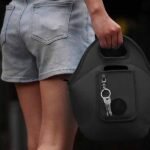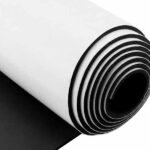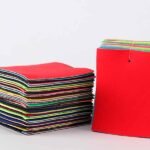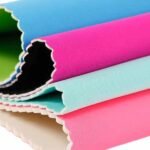In the world of neoprene goods—from high-end bags and covers to wetsuits and koozies—edge finishing is often the hidden difference between a product that looks premium and one that feels cheap. Think about it: you carry a neoprene sleeve for your laptop, you grab a neoprene beach bag, or you pull on a wetsuit. The edge where the material is cut, folded, bound or sealed is where durability, user comfort and brand perception all converge. If that edge is raw, rough, fraying, or poorly sealed, it becomes the first visible sign of compromise. On the other hand, a clean, smooth, well-finished edge enhances perceived quality, extends service life, and strengthens user experience.
Finishing neoprene edges involves choosing the right technique — e.g., fold-over binding, lycra tape, seam sealing or gluing — based on product type and performance requirement, applying correct tools/materials, and executing precise steps for durability and aesthetics.
Whether you’re making bags, covers or sport gear, mastering edge finishing improves longevity, comfort and brand value.
Imagine you’re a small designer launching a custom neoprene bag line under your new label. You’ve selected premium 3.0 mm neoprene, full custom colour, hardware and logo plate—but when the first prototype arrives, the raw cut edge looks ragged, the foam exposed, and the binding uneven. Your brand image suffers before your first sale. What if you could flip that scenario: the edge is perfectly folded with a contrasting lycra binding, no exposed foam, all hardware flush, and you deliver a sample that wows the buyer? That’s exactly the difference we’ll explore in this article—how to finish neoprene edges like a pro. So stick with me, we’ll get into each key question, method and decision you as a buyer or brand-owner need to know.
What Makes Neoprene Edge Finishing Different From Woven Fabrics?

When you’re dealing with neoprene, the finishing demands aren’t the same as for a regular woven fabric.
Because neoprene is a foam rubber laminate rather than a simple woven textile, its edges do not fray in the traditional sense—but they can shear, compress, delaminate or become exposed in a way that impacts both aesthetics and function.
Neoprene’s structure: Most neoprene used in bags, covers or wetsuits is a foam rubber (such as SBR or CR) core, laminated on one or both sides with a knit or woven fabric (nylon tricot, Lycra, etc.). This hybrid construction means that the outer fabric and the inner foam are joined under pressure and adhesive; the edge cut therefore exposes both the laminate fabric and the foam edge. Unlike a plain woven textile, where fraying threads are the main concern, neoprene edge issues include: foam compression, exposed foam cells, glue bleed, delamination under stress, and thickness variation at corners or curves.
Because of this, finish methods need to address not just appearance (tidy cut, no foam show-through) but performance: Will the edge handle repeated flexing? Will the foam compress and lose rebound? Will water, dust or abrasion attack the cut foam surface? For wetsuits, will water ingress happen along the edge or seam? For bags, will the foam edge crumble with carry-strap stress? All these factors mean that the choice and execution of edge finish methods (binding, tape, glue, folding, etc.) must be appropriate to neoprene materials, not just copied from woven fabric practices.
For example, conventional over-lock stitching might suffice for a basic knit, but for neoprene you may prefer a fold-over binding or Lycra tape finish that wraps the foam edge, reducing abrasion and maintaining foam integrity. Some resources state: “Add a strip of Lycra or fold-over elastic that has been folded in half around the rough side of the neoprene edge. This will create a non-chafing surface.”
Further, cutting tools matter more: A rotary cutter, hot-knife or die cutter helps avoid foam cell damage or uneven compression zones. Cleaning the edge, removing excess adhesive or mold-release agent before binding or sealing, may be necessary. One guide states: after cutting neoprene sheets you should “apply a thin coat of neoprene edge sealant or PVC cement along raw edges.”
In short: the unique mechanical and structural properties of neoprene (foam core + laminate surfaces) make edge finishing a more complex, performance-critical step than finishing woven textile edges. As a brand or buyer investing in custom neoprene goods (bags, koozies, covers, wetsuits, etc.), being aware of this difference will save you headaches in durability, aesthetics and user experience.
Which Edge Finishes are Most Common—and When Should You Use Each?

The most common edge finishing methods for neoprene include fold-over binding, Lycra/elastic binding, seam tape, sealed glue edges and raw edge binding—each suited for different product types and performance levels.
1. Fold-over Binding / Elastic Binding
Often used in neoprene bags, koozies and covers, this method involves folding a strip of binding material (fold-over elastic, FOE) or Lycra tape over the raw edge of the neoprene, stitching it in place. The binding covers exposed foam, presents a clean visual, adds abrasion protection and hides the rough cut edge. For example, one manufacturer suggests: “Add a strip of Lycra or fold-over elastic that has been folded in half around the rough side of the neoprene edge. This will create a non-chafing surface.” This method is especially effective for items where the edge will be touched, carried or exposed (bag rims, sleeve openings, cover edges). The binding material can be selected for colour contrast (brand accent), width (2–5 mm overlap), and stretch ratio matched to the neoprene thickness and flex.
2. Seam Tape / Glued Edge for Wetsuits and High-Performance Gear
In sport gear like wetsuits, performance matters: water exclusion, flexibility, abrasion resistance and long life. Methods like glued seams, taped seams and blind-stitch sealed edges are standard. One source outlines: “The pieces are glued or sewn, then a heat sealable tape is applied across the seam. This method ensures a waterproof seam.” Although this pertains to full seam construction, the same logic applies to edge finishing: applying a sealing tape over the raw edge or along the binding can boost water-resistance, reinforce the edge and improve durability. For example, on neoprene wetsuits, a glued + taped + blind-stitch assembly reduces edge compression and water ingress at the leg or arm opening.
3. Raw Edge with Sealant or Heat Treatment
For some neoprene accessories (mat covers, simple sleeves) the raw edge may be acceptable if sealed with a liquid or heat-set finish. A guide says: “Apply a thin coat of neoprene edge sealant or PVC cement along raw edges.” This method is easier and lower cost but may not offer the premium feel or abrasion durability of bindings or tape. Use when the edge is internal, non-visible or lightly loaded.
4. Binding vs Tape vs Raw – Decision Table
Here’s a quick comparative overview:
| Finish Method | Typical Use Cases | Pros | Cons |
|---|---|---|---|
| Fold-over binding (FOE/Lycra) | Bags, covers, koozies, accessories | Clean look, hides raw foam, brand accent | Slight added material cost, collapse at curves if wide |
| Seam tape / glued + tape | Wetsuits, sport gear, high-load edges | High durability, water resistance | Higher labour cost, tooling required |
| Raw edge + sealant | Internal edges, low-cost accessories | Low cost, simple process | Less premium look, exposed foam risk |
When to use which?
- If the product is a visible, premium display item (neoprene bag, custom cover with brand logo) – go with fold-over binding or colour-matched Lycra binding to enhance aesthetics and feel.
- If the product is sport/performance-gear (neoprene wetsuit, knee sleeve, neoprene glover) where functional performance dominates – use glued seams + tape or at least binding with sealed edges to maintain user comfort and durability.
- If the product is a budget accessory, internal lining or component edge less visible – using a raw cut edge with adhesive sealant might suffice.
As a custom neoprene manufacturer or a brand buyer working with a factory like yours (over 18 years of experience, low MOQ, custom logos, quick sampling), evaluating the right edge finish at the quotation stage is essential. Specify binding width, tape type, sealant, stitching method, visible binding colour and quality standard so that the supplier can provide accurate costings, sampling and lead times.
How do You Sew Neoprene Edges Cleanly With Home or Industrial Machines?
Yes — you can sew neoprene edges cleanly, but it requires selecting appropriate stitch type, needle size, thread, machine settings and edge preparation to avoid skipped stitches, foam perforation or fabric drag.
Machine Stitch Types & Settings
When sewing neoprene (especially > 3 mm thickness), common stitch types include long zigzag, flatlock and cover-stitch. According to a technical guide:
“Any neoprene over 4 mm in thickness will be difficult to sew with a home sewing machine and should be glued edge to edge. … The flatlock seam provides both durability and comfort.” Rockywoods Fabrics
While bag manufacturing may involve thinner neoprene (2–3 mm) making sewing feasible, thicker sheets (4mm+) often require gluing or taping rather than stitched seams. In an industrial factory like yours, using a walking foot, industrial zigzag machine or triple-needle coverstitch machine may achieve clean stitches on edge binding. Key settings: stitch length longer (to avoid perforating foam and weakening edge), zigzag width wide enough to allow stretch, tension adjusted so top‐thread doesn’t dig into foam.
Needles, Thread & Presser Foot
- Needles: For neoprene, larger size needles like Universal 16 or 18 are recommended, because the thicker foam and laminate need a larger hole for the thread to pass without overheating/melting.
- Thread: 100% polyester or bonded nylon thread is advised because of strength and abrasion resistance. Microfibres may break under foam shear.
- Presser feet: Use a walking foot or an over-edge foot that helps feed the thick material evenly. Avoid high foot pressure that compresses foam and creates ridge lines.
Edge Preparation & Stabilization
Before sewing, prepare the edge: remove excess adhesive or mold-release agent, clip curves carefully (to avoid scalloped edges or foam collapse), and apply a temporary basting glue or adhesive spray if the edges separate. Some factories use double-sided tape for positioning binding before stitching. One Reddit user noted:
“Once I was satisfied that it was straight I took a real sharp utility knife and ran it down the neoprene …”
Cutting technique influences subsequent sewing ease and edge quality.
In curved or high-stress edges (bag rims, handles), you may pre-stitch then apply a fold-over binding and stitch over that. Or glue the edge, then sew the binding through two thicknesses of binding plus neoprene—this ensures both bonding and mechanical reinforcement.
Quality Check and Common Failures
After sewing, inspect for: skipped stitches, foam bubbles under stitch line, binding lifting at corners, visible needle perforation of foam, stitching pulling out under load. In production, you may run a stretch-cycle test on the stitched edge: stretch the binding/edge 20% for 100 cycles and inspect for separation or foam tearing.
In bag manufacturing, edge stitching is visible and contributes to aesthetics; inconsistent stitches, loose threads or uneven binding can make the product look low cost. As a manufacturer serving foreign small-to-mid buyers and high-end brands (custom logo, private label, OEM/ODM), your Szoneier factory needs to show sample edge‐finishing photos, especially around handles, zippers and rim. Include edge-finish details in your spec sheet: stitch type, binding width, needle size, thread type, machine speed.
Which Bindings, Tapes, and Trims Give The Most Professional Edge?

Choosing the right trim—whether fold-over elastic (FOE), Lycra binding, seam tape or glue edge sealant—makes a major difference in both visual finish and durability of neoprene product edges.
Fold-Over Elastic (FOE) & Lycra Binding
Fold-over elastic (FOE) is widely used in neoprene apparel for binding armholes or leg openings. In bag manufacture, a similar principle applies: a narrow FOE or Lycra tape is folded over the raw neoprene edge, stitched through the fold and substrate, creating a seamless wrap that hides raw foam and gives an elastically snug edge. This detail delivers premium look and comfortable feel. The earlier guide from Rockywoods states exactly that for neoprene edging. When specifying these bindings, consider: width (e.g., 12 mm or 18 mm before fold-over), stretch ratio (e.g., 1:1 or 1:1.2 compared to neoprene edge length), colour matching (brand identity), and underside adhesive (optional) if you want better hold prior to stitching.
Seam Tape & Edge Tape
For higher performance or sports gear, applying a heat-sealable tape over a seam or binding is common. For example: “a heat sealable tape is applied across the seam … insures a waterproof seam.” While edge tape may not always be used in bag production, it is useful in high‐stress areas (zipper openings, handles, fold zones). The tape adds backing support, redistributes stress and prevents foam delamination at the edge. When ordering custom neoprene goods, ask your supplier: is the tape visible on the interior? What width/adhesive does it have? Is it colour matched?
Liquid Sealants & Heat Treatment
When a binding or tape isn’t chosen, a simpler but less premium option is liquid edge sealant or heat treatment of the edge to smooth the foam cells and stop roughness. As one site notes: “Apply a thin coat of neoprene edge sealant or PVC cement along raw edges.” This can be cost-effective for certain accessories or internal components, but for external edges that users feel or see, it often looks less refined and may wear faster.
Selection Based on Product Type
- For neoprene bags: FOE/Lycra binding gives a bold, clean finish and allows colour accents/branding. Consider binding width of 4–8 mm past foam edge, stitched with matching or contrast thread.
- For neoprene koozies/accessories: Narrow binding (2–4 mm) or even raw edge with sealant might suffice if cost is a driver and edge exposure is minimal.
- For neoprene sport gear or wetsuit accessories: Use tape or binding plus sealing, possibly triple-glued + blind-stitch + tape for water performance.
- For internal covers or lining edges: Raw edge with sealant is lowest cost—but even then, ensure foam integrity and no exposed adhesive.
As a professional manufacturer with over 18 years of neoprene R&D and production experience (such as Szoneier), you can offer buyers multiple edge finishing options in your quote: standard binding, premium tape/trimming, economy sealant finish. Provide comparative cost/lead time and show sample photos so buyers can decide.
How do You Glue, Seal, and Tape Neoprene Edges Without Sewing?
Yes—when sewing is difficult or the edge must be watertight, you can finish neoprene edges with glue, sealant or tape only. Understanding when and how makes the difference between “okay” and “professional grade”.
Adhesive Sealing
One of the go-to methods for neoprene gear is to apply contact cements or neoprene-specific adhesives to raw edges, clamp them, allow curing, then optionally apply tape or stitching. According to SewingNeoprene-Bag guides: “Edge Sealing. Liquid Sealants: Apply a thin coat of neoprene edge sealant or PVC cement along raw edges.” For example, in a neoprene laptop sleeve, you might glue the edge (foam-to-laminate) and fold over a binding or tape without stitching, producing a clean, weld-like finish.
Tape Sealing & Heat Press
In performance neoprene gear, after gluing or in lieu of stitching, you apply a heat-activated seam tape over the formed edge. This process involves precise temperature, pressure and dwell time so that the tape melts into the laminate and foam, forming a waterproof bond. As previously noted: “The pieces are glued or sewn, then a heat sealable tape is applied across the seam. This method insures a waterproof seam.” For bags, this exact method may be overkill, but using a narrow polyester tape over handle edges or zipper flanges adds robustness.
When to Choose Glue/Tape vs Stitch
| Scenario | Why glue/tape-only may be better | Limitations |
|---|---|---|
| Thick foam > 4mm, too bulky to stitch | Avoids needle perforation and foam damage | May add cost for tape, requires special equipment |
| Watertight product (wetsuit, paddle gear) | Sealing is critical over appearance | Lead time/test needed, higher skill required |
| Simple accessory with no visible stitches | Clean surface, minimal hardware | Less flexibility, potentially less mechanical strength than stitched binding |
Step-by-Step Example (Edge for Bag Cover)
- Clean cut edge, remove mold-release or excess adhesive.
- Apply thin bead of contact cement along foam edge; let tack per manufacturer data.
- Fold edge if required, clamp or hold in jig until adhesive cures.
- Apply narrow seam tape (e.g., 12 mm polyester tape) over fold, use heat press (e.g., 160 °C, 5 seconds, ~0.3 MPa) or hot-air if handheld.
- Inspect edge for any foam show-through or tape lift, trim excess.
- Optional: Top-stitch binding over tape for aesthetics and reinforcement.
In a custom manufacturing scenario, your factory (e.g., Szoneier) should provide process details in the spec sheet: adhesive type (e.g., neoprene contact cement A123), tape specification (width, adhesive weight, peel strength), heat press setting, clamp time, and quality test criteria (e.g., 10,000 flex cycles with <2 mm lift). This transparency helps buyers feel confident in edge durability.
Do Cut Methods Change The Final Edge Quality?

Absolutely. The way you cut the neoprene sheet or part prior to edge finishing significantly influences how clean and uniform the edge will be—and thus how the binding, tape or seal will perform and look.
Cutting Tools & Their Effects
- Die cutter / clicker press: Offers very clean, repeatable edge profiles, minimal foam compression, consistent thickness. Ideal for mass production of bags, covers and accessories.
- Rotary cutter or flatbed cutter: Common in sample making; works for thinner neoprene but may cause foam cell collapse at edge, or “fuzzy” foam appearance requiring extra trimming or sealing.
- Hot knife / laser cutter: Useful for certain foam types (especially CR neoprene), because heat seals the cut edge slightly, reducing foam cell exposure. However, heat can damage the laminate if too hot or slow. One board game-neoprene thread noted: “There is a tape specifically made for seaming and edging neoprene. … the OP specifically expressed a preference for not seaming the edges …” This hints that cutting technique and edge condition can affect binding adhesion or tape performance.
Edge Preparation Metrics
| Cutting Method | Edge Condition | Impact on Binding/Tape |
|---|---|---|
| Die cutter | Crisp, minimal foam deformation | Best bonding surface, minimal trimming |
| Rotary cutter | Slight foam compression | May need light sanding/cleaning |
| Hot knife | Slight melt-seal, clean edge | Good for tape adhesion, risk laminate melt |
Why This Matters for Production
Imagine you’re ordering a batches of 500 neoprene laptop sleeves with 3mm foam, custom colours and logo embossing. If the edges come with foam fuzz or uneven thickness, your binding will appear bulky or uneven, trim overlap might vary, and tape may lift at high-stress corners. In turn, your brand perception drops. On the other hand, specifying die-cutting and smooth edge prep up-front helps ensure consistent width, minimal trimming and faster binding/edge finish application. For your factory with 18+ years of neoprene R&D, you should highlight your cutting tooling in your capabilities: “Precision die-cutting ensures ±0.25 mm thickness variation, smooth edge ready for binding or tape, reducing trimming and improving consistency.” This messaging builds buyer trust.
Recommendations for Buyers
- Always ask for sample edge cross-sections to inspect foam/laminate integrity.
- Specify cutting method and check tooling cost implications.
- At quoting stage, include “edge width tolerance ±0.3 mm after cutting” and “foam cell exposure < 5 %” as quality metrics.
- Review binding/tape supplier compatibility with your chosen cutting method: e.g., hot-knife may pre-melt foam and change adhesive uptake of tape.
Cutting may seem a pre-production detail, but for neoprene products it directly impacts edge finishing quality, cycle time, waste rate and final presentation. As a brand-owner you’ll want your manufacturer (such as Szoneier) to articulate both cutting and finishing processes clearly in your spec sheet.
Which Finish is Best for Your Product Category?

The “best” edge finish depends on your product category, brand positioning and end-user expectations. Let’s map finish methods to typical neoprene product categories to help you decide.
Product Categories & Recommended Finishes
1. Neoprene Bags (Sleeves, Beach Bags, Laptop Cases)
- Primary priorities: Aesthetics, brand look, comfort for user (no scratchy edges), durability under carry strap load.
- Recommended finish: Fold-over binding (FOE or Lycra) with top-stitching. For high-end versions, binding + narrow seam tape inside rim for reinforcement. Binding width 4–6 mm past foam edge, contrast or brand colour. Stitch zig-zag or cover stitch for flexibility.
- Why: The binding hides foam edge, gives soft hand feel, adds visual brand accent. A sealed or taped edge adds durability in high-stress zones like bag openings or handles.
2. Neoprene Koozies / Accessories
- Primary priorities: Low cost, quick production, flexible shape, frequent handling.
- Recommended finish: Narrow binding (2–4 mm) or raw edge with liquid sealant (for very budget friendly). Optionally binding only at high-touch zones.
- Why: Accessories have shorter life cycles; budget is more critical. But even here, if you’re building a brand, a binding edge gives a visible quality upgrade.
3. Neoprene Covers / Organisers
- Primary priorities: Moderate stress, appearance counts, user will often touch edge or carry by edge.
- Recommended finish: Binding or binding + tape; avoid raw foam edge. Optionally add internal seam tape for durability if product is flexed frequently.
- Why: The edge is visible and part of the user experience (e.g., a camera wrap cover, cushion cover), so finish must be clean.
4. Neoprene Wetsuits / Sport Gear / High-Performance Items
- Primary priorities: Performance: water exclusion, flexibility, minimal irritation at skin contact, strong durability under repeated cycles.
- Recommended finish: Glued seam or edge, followed by seam tape, and binding/lycra at openings if needed. Blind-stitch + tape + internal edge finishing recommended.
- Why: Performance demands exceed aesthetics alone. Edge finishing is critical for comfort and longevity. The previously referenced guide says: “The flatlock seam provides both durability and comfort… you’ll want to experiment with scrap pieces.”
Cost vs Quality Trade-Off
When negotiating with your manufacturer, you should map desired finish to cost premium. For example:
- Basic raw cut + sealant – baseline cost.
- Narrow binding only – +5–8% cost.
- Binding + top-stitching + colour contrast – +10–15%.
- Binding + tape + high-load reinforcement – +20%+. You should ask your manufacturer (such as Szoneier) to provide a “finish matrix” with cost deltas and lead-time impact, so you can choose appropriately for your market.
Brand Positioning & User Perception
As you build your brand identity, the edge finish becomes part of the visual and tactile language of your product. For a premium brand, visible binding in a contrasting brand colour (e.g., your factory could offer custom FOE in brand PMS colour) signals attention to detail. For eco-oriented gear, maybe the binding is un-coloured, raw edge sealed, emphasising minimalism and material authenticity. Always align the edge finish with your brand story.
As a buyer working with a manufacturer with 18+ years of neoprene manufacturing experience and low-MOQ custom capability, you should ensure your specification sheet includes: binding material & width, tape type & width, glue type (if applicable), stitch type & machine used, cutting method, edge finishing tolerance, and durability test criteria (see next section).
How Do You Test Durability and Comfort After Finishing?
You’ve finished the edges — now how do you ensure they will hold up under real-life use? Testing durability and comfort is the final, critical step in the specification chain.
Durability Tests
Some of the key tests for neoprene edge finishing include:
- Flex/Stretch cycle test: The finished edge (binding or tape) is flexed repeatedly (e.g., 5000 cycles at 20% extension) and examined for lifting, delamination or foam exposure.
- Abrasion test: Edge is rubbed against standard abrasive material at set load (e.g., 2 kg) for e.g., 1000 cycles; binding fabric should not fray, tape should not peel, foam edges should not collapse.
- Peel/adhesion test (for tape/glue finishes): Measure peel strength (e.g., 180° pull) of tape from laminate/foam interface; compare to spec (e.g., > 3 N/cm).
- Load test (for bag edge bindings): Simulate handle stress: hang 5× unit weight from rim edge for 72 hours; inspect binding seam, foam edge, stitching integrity. These tests help flag early failures such as tape lift, binding separation at corners, foam crumb during stress, or stitch perforation expansion (holes splitting under load). In your manufacturing spec, you should ask: “Factory to supply test report showing flex test result, peel strength and visual inspection for edge finish.”
Comfort & Visual Checks
Since edges are tactile (users touch them) or visible (brand presentation), you also need to check:
- Hand feel: Binding should not be stiff, edge should not feel sharp or scratchy. Fold‐over binding should present a smooth surface.
- Edge appearance: Colour consistency, no visible foam cells, uniform binding width, consistent stitching/trimming.
- Irritation risk (for wearable gear): On skin contact edges (wetsuit cuffs, gloves, neoprene glover openings) check for burrs, exposed glue, raised tape seams, stiffness or binding overlap protruding. For example, one guide emphasises non-chafing finish: “This will create a non-chafing surface.”
Specification Inclusion & Sample Approval
To engage your manufacturer effectively (e.g., Szoneier), you should include these test requirements in your tech pack: edge finish method, sample approval criteria (appearance, hand feel, flex test result), acceptable tolerances (binding width ±0.5 mm, stitch count ±2 stitches/cm, foam cell exposure < 2%). Ask for pre-production sample with full edge finishing and test report before mass production.
Post-Production QC Checklist
When your production arrives, your QC checklist should include:
- Binding width uniformity at all edges and corners.
- Stitching: no skipped stitches, no thread tails, consistent tension.
- Tape: no lift, uniform adhesion, correct width coverage.
- Foam edge: no exposed foam cells, no compression marks, no uneven trimming.
- Edge finish corners: no excess bulk, binding fold remains smooth, no separation at high‐stress points (handles, hinges). By treating edge finishing not as an after-thought but a key quality metric, you elevate product durability, minimise returns and build brand credibility.
Conclusion
Finishing neoprene edges is far more than just tidying up the cut: it’s a critical intersection of material science (foam + laminate), manufacturing precision (cutting, binding, tape, glue), stitching or sealing, and user-felt experience (durability, comfort, brand aesthetic). Whether you’re launching a neoprene bag line, a range of neoprene koozies, a protective cover or high-performance neoprene gear, selecting the right finish method, preparing the edge properly, performing rigorous stitching or sealing and validating via test methods will separate a mediocre product from a market-leader.
At Szoneier, with over 18 years of experience in neoprene R&D, manufacturing and sales, we specialise in custom neoprene products including bags, koozies, gloves, covers, wetsuits and more. We offer 100% quality assurance, free design, low MOQ customisation, quick sampling, free sample provision, and short lead times. If you’re looking to produce products with custom branding, private-label logic or OEM/ODM requirements — ask us how we handle edge finishing options, binding colours, tape specification and sample test reports. Let’s bring your next neoprene product line to life with premium finishing that stands out. Contact us today for a quote.











